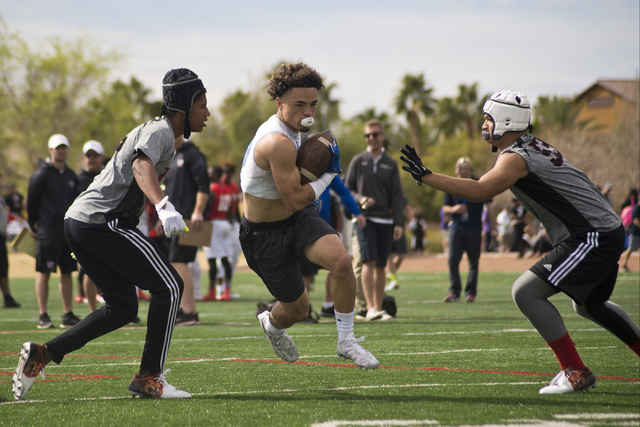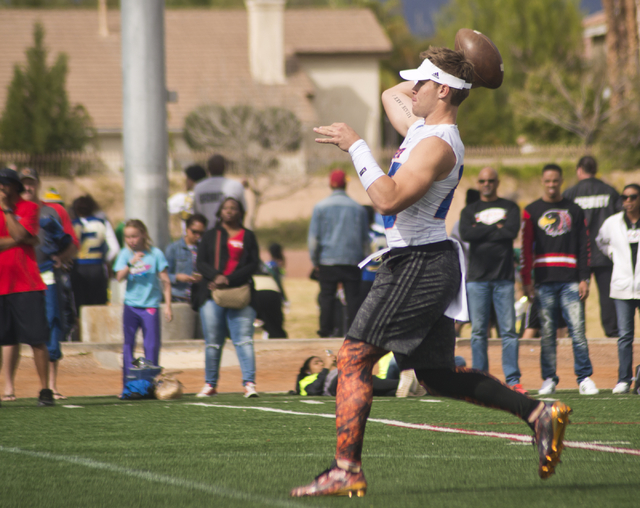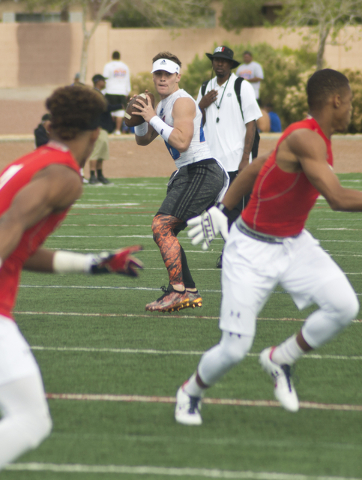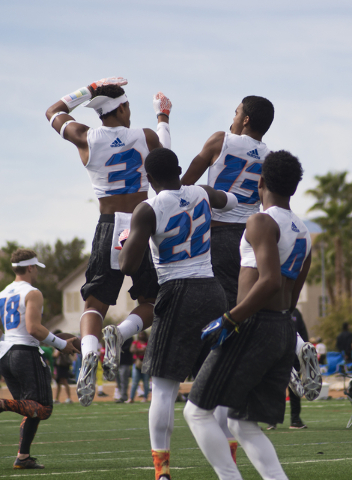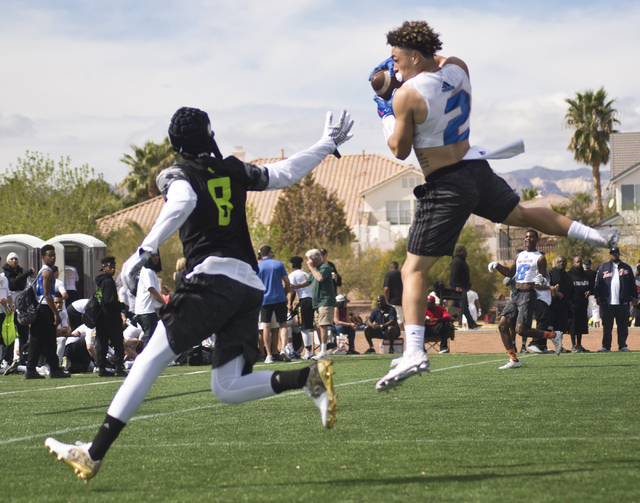7-on-7 football gains respect among players despite skepticism by college coaches
The conversation between a parent and referee during a recent 7-on-7 football tournament started off friendly. It was mostly good-natured ribbing, but after a minute or so, the back-and-forth started to escalate.
Sensing the tone had shifted, the official tried to end the exchange.
“It’s not like anybody’s getting a scholarship out here,” he said.
Let the debate begin.
College coaches are more likely to describe the increasingly popular 7-on-7 events as football’s version of the travel basketball circuit. A competitive, yet unregulated environment that mostly serves to quench fans’ thirst for offseason recruiting news.
“You could send me all the 7-on-7 film you want, and you know how much I’m going to watch?” UNLV coach Tony Sanchez said. “None.”
But talk to high school athletes, parents and Internet talent evaluators and 7-on-7 is an essential part of the effort to earn a scholarship.
After all, baseball and volleyball have club teams, so why not football?
“There’s some carryover as far as route combinations, accuracy, quarterback, all that stuff,” first-year Hawaii coach Nick Rolovich said. “I don’t see where it’s a terribly bad thing for our kids to be out there doing something physical and trying to get better at their craft. But you still need to figure out when the pads come on, what is that young man made of?”
The event in Las Vegas, the Pylon Elite 7v7 National Tournament, was March 5-6 at All American Park and drew close to 175 teams from across the U.S. and Canada.
The high school division undoubtedly was the featured attraction with many of the nation’s top skill-position prospects, including running back Najee Harris of Antioch, California, Scout.com’s No. 1 player in the class of 2017.
That’s how Baron Flenory envisioned it nearly a decade ago. Flenory was a hard-hitting safety at New Hampshire from 2001 to 2005 and co-founded New Level Athletics in 2007, holding 7-on-7 camps and tournaments at colleges across the country, including UNLV.
In April 2013, Oregon self-imposed penalties after the football program committed a major NCAA violation from 2008 to 2011 for payments of more than $45,000 to at least three recruiting services, one of which was New Level Athletics. (Chip Kelly, Oregon’s coach at the time, was New Hampshire’s offensive coordinator during Flenory’s college career.)
The NCAA also took a hard look at 7-on-7 football in 2011 amid growing concern over the large number of “non-scholastic coaches” at the tournaments, but its popularity mushroomed. Flenory rebranded New Level Athletics to Pylon Elite Camps in 2014.
“That opposition that was once there and the hurdles, getting over not being able to do it on college campuses and that AAU basketball stigma,” Flenory said, “people are now not only saying, ‘OK, this is here to stay,’ but they’re also embracing it.”
In 7-on-7 football, offenses consist of a quarterback, five eligible receivers and a center, who is replaced with a stool designed to hold the ball for the QB presnap. Drives start at the 40-yard line, and the offense has three plays to get a first down past the 25-yard line, three more plays to get to the 10 and another three plays to score.
The stool/center is equipped with an alarm, and quarterbacks have four seconds to throw or it’s a sack. Games last 25 minutes with a running clock, and there’s a 25-second play clock.
Otherwise, it’s run-toward-the-Toyota touch football with few running plays and zero blocking.
“Not putting on pads and actually just being able to run around and do whatever you want basically, it’s just fun,” Bishop Gorman junior quarterback Tate Martell said. “And it’s highly competitive.”
Martell’s 702 Elite team won the high school division. The squad featured several of his Gorman teammates on the 25-player roster and was sponsored by adidas.
“I wish there were high schools out there doing it with the high school unit and not necessarily all these specialized teams,” Sanchez said.
Stanford coach David Shaw was asked about the sport at the recent Nike Coach of the Year clinic in San Diego and was widely quoted on Twitter as saying, in part, “7-on-7 is not football” and “it means absolutely nothing to me as an evaluator.”
NCAA rules prevent college coaches from attending 7-on-7 tournaments. Yet, more players than ever are running post patterns in shorts and T-shirts and risking injury in an effort to get noticed by recruiters.
LV Select, which finished fifth in the high school division, practiced once a week for more than a month in preparation for the Pylon 7v7 tournament, according to coach Jeromy Oblad.
Oblad said his son Kenyon, a sophomore quarterback at Liberty, didn’t participate in 7-on-7 last season and he regretted missing an opportunity to get his son exposure. Kenyon Oblad has early scholarship offers from Brigham Young and Colorado State.
“I don’t think college coaches could care less about 7-on-7, honestly,” Jeromy Oblad said. “But there’s a lot of pomp and circumstance, and any way to get guys’ names in front of college coaches is valuable.”
The discussion surrounding 7-on-7 football isn’t likely to end soon.
By virtue of winning the 7v7 National Tournament, 702 Elite qualified for Pylon’s 16-team national championships July 4 in Dallas. And in possibly the surest indicator of the sport’s increasing legitimacy, 7-on-7 football is scheduled to be part of the AAU Junior Olympic Games July 27 to Aug. 6 in Houston.
“These guys still want to play real football. This isn’t going to be a substitute,” said Steve Wiltfong, director of recruiting for 247Sports. “But they come out here, and they get their name written enough times, and college coaches see it through social media.
“ ‘This kid was great in that tournament, this tournament, let’s see how he is in real 11-on-11 football.’ Most of the time, there’s a connection. Most guys that are good out here are good on Fridays.”
Contact reporter David Schoen at dschoen@reviewjournal.com or 702-387-5203. Follow him on Twitter: @DavidSchoenLVRJ



